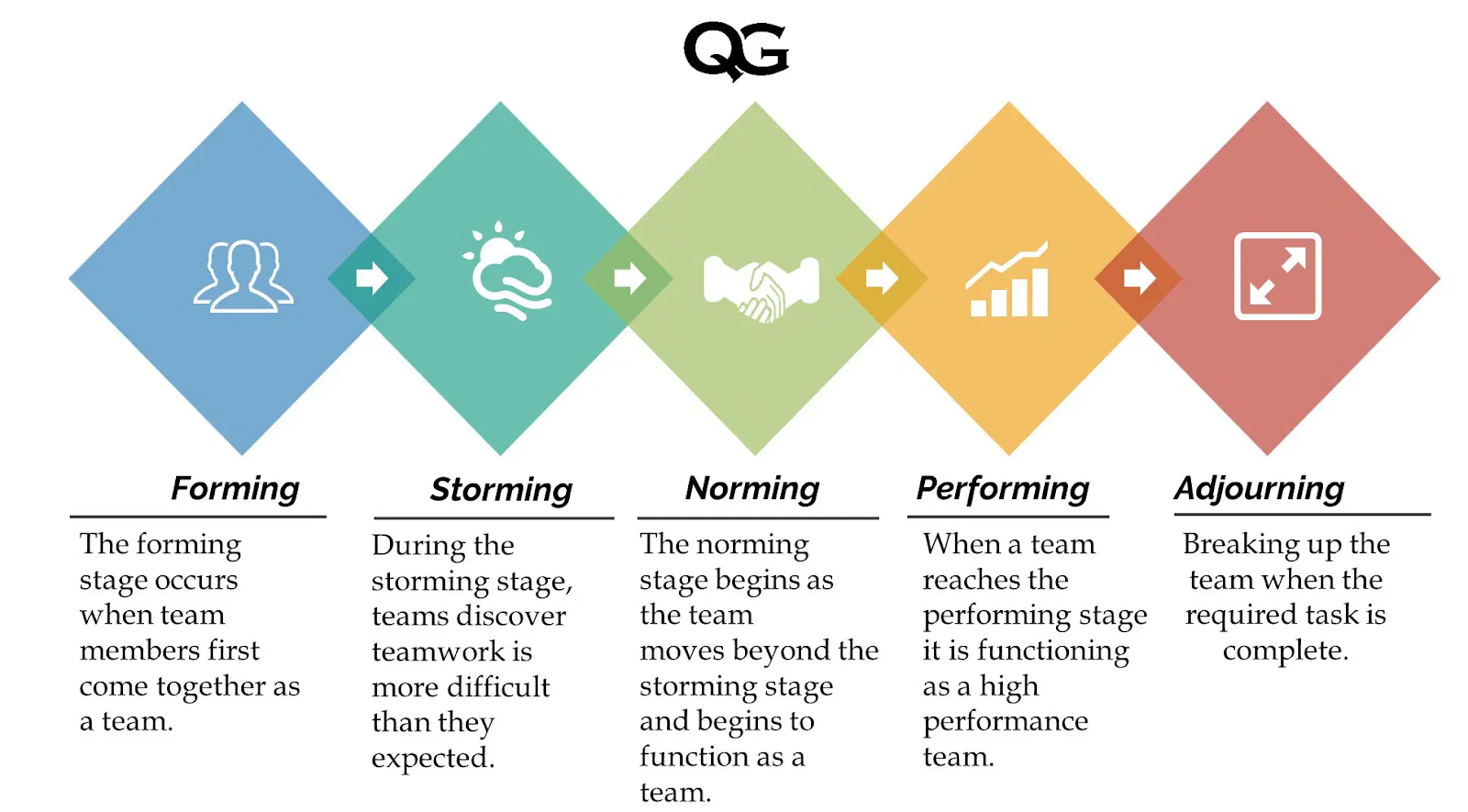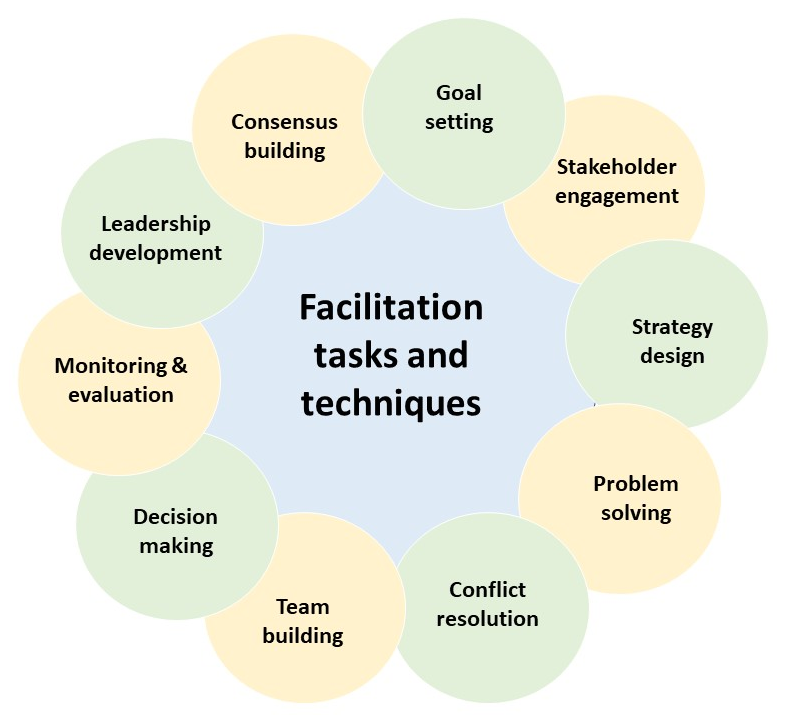Team development is very much part of one process to achieve the targets the team has set. A good model for understanding the team development process is Tuckman's Stages: "Forming, Storming, Norming, Performing." The forming stage is where one recognizes the functions of the individuals. The storming stage is mostly a stage at which conflicts arise, where the behaviors of the team are being queried and tested. The norming stage is where the resolution of the conflict takes place; the team process becomes solidified. And lastly, the performing stage is where a group acts as one, duly working out the targets of the team.
Introduction to team development
Team development is crucial as it predominantly influences the overall operation of a team and its performance. The process of team development is based on the model of Tuckman's Stages of Forming – Storming – Norming and Performing. These four stages incorporate forming stage, storming stage, norming stage, and performing stage. Each stage registers a transition in the team behavior, roles as well as goals. In this point of view process stage, team development entails a comprehensive analysis and management of the stages toward attaining an integrated, focused, and purposeful team.
The importance of team development in agencies
It encourages mutual team behavior and works jointly towards the goals of a team. The process of the team development period is broken down into some stages with the help of Tuckman's Stages; forming stage, storming stage, norming stage, and performing stage. The whole process is systematic in nature that helps in clarifying the role of team members and streamlines the team process.
Every stage of development has a unique specific purpose. Forming allows the team to set some expectations; during storming, the team gets to do some brainstorming and also resolves conflicts. Sometimes the team has to develop some common practices which are set during the norming stage, and finally, performing is the stage where the main focus is actually on working toward reaching team goals. Therefore, effective team development is necessary for an agency to drive a success story.

Project planning is a critical component of project management. Bonsai provide integrated platforms that consolidate projects, clients, and teams, offering features like task management, time tracking, and reporting, which are essential for successful project delivery. Bonsai's resources can help agencies match project requirements with team members' skills, ensuring that each task is assigned to the most capable individual.
Overview of the stages of team development

More precisely, the stages of team development, or rather Tuckman's Stages, are divided into four key steps: forming, storming, norming, and performing. Team goals are passed in the forming stage and when team roles are designated. The team stages characterized by tensions and disagreements create room for the storming stage, which more often have an impact on the behaviors of the team and the overall team process. Consequently, the norming stage follows, and in this stage, resolutions through which smooth running of operations for the team are made. Last but not least, the team proceeds to the performing stage where they operate consensually and an achievement of set goals is made. With that said, every team development stage must follow the above steps in order to create effective team dynamics.
Origins of the team development model
The team development model was a result of Bruce Tuckman's 1965 theory. Tuckman proposed that teams proceed through five different stages of development: forming, storming, norming, performing, and adjourning. In other ways, these stages describe distinct team behaviors and goals. Forming is the stage meant for the creation of a team, whereas storming is characterized by conflict and power. The norming stage sees a team in the resolution of conflict and agreement on the team process. Performing is the stage where a team works efficiently toward common goals. This model has enjoyed prevalent application to describe the dynamics of team roles and the overall team development process.
Stage one: Forming
The first of tuckman's stages is the forming stage, a critical phase in the team development process. This stage Is characterized By cautious and polite Behavior As team members get to know each other and understand team goals. Individual roles are not clear yet And The team process is just beginning to form. The forming stage sets the base for the team's journey through the Next Stages: storming, norming, and performing.
Team Behaviors During this stage are generally positive and polite. Members are Excited, Anxious But also somewhat uncertain about their roles. The primary focus is On Establishing relationships, understanding team roles, and setting initial team goals.
Characteristics of the forming stage
The forming stage is the first in tuckman’s stages of the Team Development process. During this stage, individuals are introduced and start to understand their team roles. The main team Behaviors Exhibited include polite interaction, information gathering, and establishing team goals.
Uncertainty is a characteristic of the forming stage, as team members try to comprehend the team process and their place in it. It is crucial for leadership to be Strong during this stage, to guide the journey from forming to storming, Help Set future expectations, and Create A safe space for interaction.
Lastly, in the forming stage, decisions are mostly made by higher authorities or team leaders rather than collective agreement. The overall aim of this stage is To lay the foundation for Latter Stages Such As storming, norming and performing.
Role of leadership in the forming stage
In the forming of tuckman's stages, leadership Plays a crucial role In guiding the team's development process. Leaders establish the team goals, define Team Roles, and standardize the team process. Leadership helps facilitate positive team Behaviors And sets the tone for the upcoming storming, norming, and performing stages.
Being the initial part of the team development process, the forming stage is where leaders identify individual strengths and weaknesses to ensure an effective team composition. They also Instill A culture of open communication and respect, setting the groundwork for future stages of development.
Stage two: Storming
The next phase in tuckman's stages is the storming stage, following the forming stage. This stage is often highlighted by conflict As individual team roles Are established And various team Behaviors Emerge. Debates can become intense as team members Begin to Advocate for their opinions regarding team goals and the team process.
As part of Stages Of development, storming is crucial to establish a diversified yet unified flow of work within the team, paving the path for the next stages, norming and performing. It's a pivotal divider towards a mature team development process.

Understanding conflict in the storming stage
The storming stage is An Essential Part of Tuckman's stages in the team development process. During this phase, conflict often arises due to competing team roles and varying interpretations of team goals. Such clashes are typical in this stage of development as It Reflects The diverse approaches and attitudes within the team towards the tasks.
This stage can disrupt the initial collegiality experienced in the forming stage. However, by navigating the storming stage effectively, teams can solidify their process, leading to a more harmonious norming stage and Ultimately a Successful performing stage.
Strategies for navigating the storming stage
During the storming stage of tuckman's stages, team Behaviors Significantly influence the team development Process. to navigate this stage, initiate open discussions to address interpersonal conflicts and clarify team roles. Encourage everyone to accept differing perspectives and find common ground on contentious points.
Promote a shared understanding of team goals and prioritize tasks essential to the team process. Regularly reminding the team of The things that Brought them together during the forming stage can also be beneficial. Ultimately, a team's success in the storming stage prepares them for the norming and performing stages.
Stage three: Norming
The norming stage in tuckman's Stages Of team development Process, Comes after the Storming Phase. During this stage, team behaviors start to shift as team members begin to resolve their conflicts and work towards achieving their team goals collectively. Following Are key aspects of this stage:
- Clear team roles are defined
- Increased collaboration and harmony within the team
- Consensus in team processes and norms Is achieved
This stage presents a substantial amount of growth within individuals and the team as a whole, creating an environment conducive to achieving team goals efficiently and effectively.
Establishing team norms and standards
Establishing team norms and standards is crucial in the team development process. This process Generally Follows tuckman's stages, which involves forming, storming, norming, and performing. In the forming stage, team roles are defined and the team goals are set.
Proceeding to the storming stage, team behaviors begin to emerge which can potentially challenge the progress of the team. Following this difficult stage, the norming stage is where established norms and standards guide the team process. Ultimately, the performing stage Is achieved Where The team operates efficiently towards defined goals. The establishment of team norms and standards is integral in each of these stages of development.
Building trust in the norming stage
In the norming stage of tuckman’s stages, team Behaviors Start To solidify Around team goals, fostering trust among members. This stage is crucial in the team development process as it sets the tone for team roles and how each member contributes to the overall objective.
Building trust during this stage involves open communication, Acknowledgments Of individual strengths, and demonstration of mutual respect. This Encourages collaboration, unifying the team, and enhancing the team process.
Stage four: Performing
The performing stage is the final phase in tuckman's stages of the Team Development process. At this point, the team has successfully navigated the forming, storming, and norming stages, achieving a balance of team roles and behaviors. This stage is characterized by a high level of comfort, cooperation, and productivity.
Here, the focus shifts towards achieving team goals, and members work collaboratively, demonstrating a deep understanding and efficiency in the team process. Success in the performing stage signifies a mature and well-functioning team.
Characteristics of high-performing teams
High-performing teams pass through several stages of development Including The forming, storming, norming, and performing stages. The forming stage involves defining team goals and establishing individual team roles. The team process involves stages of initial harmony, conflict (storming stage), resolution (norming stage) And Finally reaching optimal performance (performing stage).
linkedin.com
Key characteristics of such teams include excellent team Behaviors Such as open communication, individual accountability, and mutual respect. They often follow The Tuckman's Stages, a model that describes a team development process. These characteristics enable them to effectively manage transitions between different stages and achieve their set goals.
Maintaining performance and motivation
Maintaining performance and motivation is key in all stages of development in any team process. Forming, storming, norming, and performing, or tuckman’s stages, stress the importance of efficient team Behaviors To achieve team goals effectively.
The team development process involves various team roles and it is crucial to establish an atmosphere of motivation from the forming stage, through the storming stage, into the norming stage and finally, towards the performing stage.
By understanding these factors, teams can better navigate through challenges, ensure long-term success, and maintain a High performance Level throughout.
Stage five: Adjourning
The final stage in Tuckman's stages is adjourning. By then, a team will have succeeded in reaching its goals and it's the right time to close up the collaboration. The stage denotes the completion of the team development activity. The adjourning stage happens when the team has performed. It consists of reflecting on one's team roles, the achievement of team goals, and the total behaviors of the team in the stages of development like forming, storming, norming, and performing stages. The essence is to draw a lesson from the team process and extend it to the subsequent team interactions.
Managing team transitions and endings
The last stages in team development usually contain aspects of transition and even an ending, according to Tuckman's stages (norming, storming, forming, performing). The process of transition is essential to the success of the goals of the team as behaviors in the group will change as roles change or as people leave the group. The performing stage is not the end. It merely reflects that team development has been a success. At this point, the team can either disperse or move into another forming stage where the team process is maintained, and new goals set.
Common challenges in team development
Developing teams often experience many challenges at various stages of development, specifically during the forming, storming, norming and performing stages. Miscommunications, conflict, and a lack of clarity in team roles often peak during the storming stage, which can be a significant deterrent to the team process. Another common problem involves the setting of and adherence to team goals. Many teams often have difficulty with the norming stage where goals are outlined and subscribed to by team members. Not managing these challenges well can deter reaching the desired performing stage where optimal teamwork and efficiency are achieved. Tuckman's stages can be used to better understand and apply the application of team use during these challenges.
Overcoming communication barriers
Overcoming communication barriers is a paramount challenge in the team development process. This journey often follows tuckman’s stages, encompassing the forming, storming, norming, and performing stages.
In the forming stage, aligning team goals is central, whilst during storming, conflicts based on team roles and behaviors may arise. However, these obstacles can be mitigated through proactive communication strategies.
Norming sees the team start to work fluidly within the team process, and performing optimizes this process. Efficient communication is crucial in every stage, facilitating progression and aiding in the resolution of disputes.
Addressing team dynamics issues
Team dynamics issues can be addressed through understanding tuckman’s stages of team development, namely: forming, storming, norming, and performing. The team development process involves managing various team Behaviors Throughout these stages. For instance, in the forming stage, clearly defining team goals is vital to streamline team work and focus.
The storming stage often presents conflicts and requires balancing differing viewpoints and establishing clear team roles. The norming stage fosters cohesion, promoting a harmonious team process. Lastly, during the performing stage, high productivity marks the successful implementation of the previous stages. Recognizing and addressing issues at each stage is Key For Effective team management.
Tools for facilitating team development

Different tools to help understand and navigate through the different stages of team development, which lead to the development of a team, can be further described as: identification of team roles, resolving conflicts, setting goals for the team, and process improvement tools.
Forming, Storming, Norming, and Performing stages explain what behaviors and changes in team dynamics will occur through time. Tools like identification of team roles help in the forming phase, resolving conflicts will be at the storming phase, setting up goals for the team in the norming phase, and process improvement tools in the performing stage. These earmark specific points where tools can facilitate smooth transitioning between the stages and fine-tune team performance.
Using slack for effective team communication
Slack is an effective communication platform that supports team process and team behavior at every stage of development. The whole platform involves all Tuckman Stages: forming, storming, norming, performing, which can be clearly exemplified and arranged in a digital workspace. At the forming stage, team goals can be clearly set, and work on team roles can begin. The storming stage may bring lively discussion to the platform. The ease of communication also supports the norming stage well and, finally, the effective stage at performance.
Leveraging Trello for task management
Trello is an excellent application in facilitating the management of activities at several stages of development within a team. In specific terms, it greatly aids a team in forming by enabling clear definition of the roles of members, allowing the team to behave effectively, and therefore keeping in alignment with what has to be done to achieve ahead. In general, tools like Trello help in this team process during the storming and norming stages by tracking progress, assigning tasks, and instant communication. Ultimately, while at the performing stage in the process of Tuckman's Stages of Team Development, tools further peak productivity and the need for continuous progression of teams.
Conclusion: The continuous nature of team development
The team development is an ongoing and dynamic process. It flows through the key stages of development, which include forming, storming, norming, and performing. Team behaviors, roles, and goals are not static, and they may change with every stage. The Tuckman Stages offer a key tool to understand this ongoing journey. The stages are not a linear process: the storming, norming, and performing may repeat in the case of a response to the changing goals of a team or a change in the team structure. The ability to navigate between the stages and ensure healthy team processes comes from the study of the stages.






